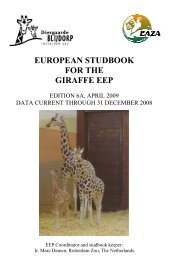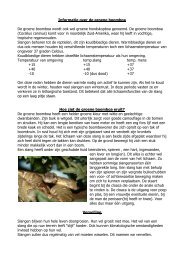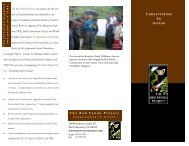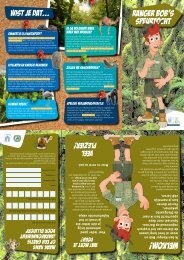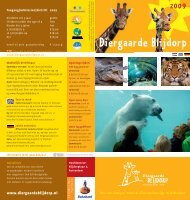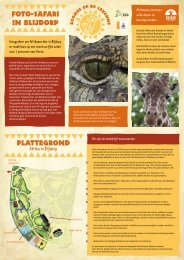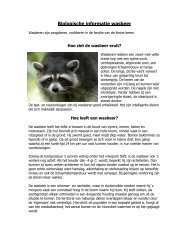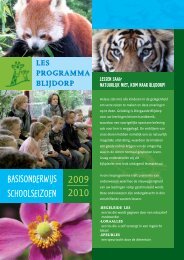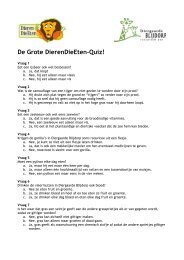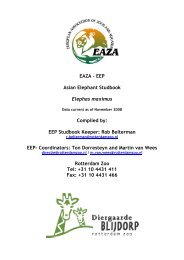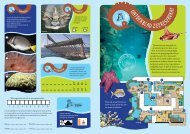Create successful ePaper yourself
Turn your PDF publications into a flip-book with our unique Google optimized e-Paper software.
EUROPEAN STUDBOOK CROWNED PIGEONS<br />
5.7 Health<br />
In this paragraph a couple of examples will be given about infections that occur in crowned<br />
pigeons. Three cases will be illustrated in which crowned pigeons died unexpectedly or get<br />
infected with parasites as well as possible causes. In many cases infections can be prevented by<br />
taking precautionary measures.<br />
Toxoplasmosis<br />
Toxoplasma gondii has a worldwide distribution and is a common disease in crowned pigeons.<br />
Virtually all vertebrate species are susceptible to infection (Garell, 1999). Domestic and exotic<br />
felids are the only known definitive hosts of this parasite and as such are the only animals capable<br />
of completing the enteroepithelial life cycle of the parasite and shedding oöcysts in their faeces<br />
(Dorrestein et al, 2002).<br />
In 2001 four Scheepmaker’s crowned pigeons (Goura scheepmakeri sclaterii) housed in the<br />
same enclosure died unexpectedly within 4 days. All birds were in good to excellent condition and<br />
most birds still had food in the proventriculus. During the post mortem, toxoplasma-like organisms<br />
were seen in the lungs, liver, spleen and intestines. Infection through contact with cat faeces of<br />
these pigeons could be in consequence of the leaves collected in the zoo for breeding purposes. But<br />
also food polluted with cat faeces can often not be excluded (Dorrestein et al, 2002).<br />
Sticktight flea<br />
A 12-year old female Victoria crowned pigeon acquired from a private aviculturalist, was<br />
diagnosed with a flea infestation during a quarantine examination. The fleas were embedded<br />
around the face and throat and were identified as sticktight fleas (Echidnophaga gallinacea).<br />
Although this parasite has the potential to induce morbidity and mortality, no feather loss, localized<br />
dermatitis or anaemia were noted in response to the ectoparasitism. The infestation was treated<br />
with manual removal of fleas combined with topical malathion dusting and environmental<br />
treatment. Subsequent recheck exams did not reveal any fleas on this pigeon or on any of the other<br />
birds housed in the same room (Zoltan et al., 2007).<br />
This case illustrates the importance of quarantine procedures for newly acquired birds as<br />
part of responsible captive management of a large, multispecies bird collection (Zoltan et al.,<br />
2007).<br />
Sarcocystis<br />
Three Victoria crowned pigeons housed in a totally enclosed free-flight tropical exhibit died within<br />
9 days of each other without showing signs of illness. No significant medical problems had been<br />
noted with the birds. The horticulture department had placed new soil from an outdoor source<br />
located on zoo grounds in several areas of the building 10 days prior to death of the first bird.<br />
Immunohistochemical staining identified a Sarcocystis falcatula-like parasite in all three birds<br />
(Suedmeyer et al., 2001). Sarcocystis species are coccidian parasites and are ingested by the<br />
intermediate host.<br />
It is suspected that new exhibit soil contaminated with faeces from the Virginia opossum<br />
(Didelphis virginiana) was the source of the infective sporocysts. To help prevent future infections,<br />
outdoor horticulture soil should not be placed directly in animal exhibits. The deaths of these three<br />
birds documents the possibility of indoor infections with Sarcocystis falcatula-like organisms,<br />
which have been previously reported only in outdoor aviaries. Veterinarians and zoo professionals<br />
should be aware that infection with Sarcocystis falcatula can occur in totally enclosed aviaries<br />
(Suedmeyer et al., 2001).<br />
171



